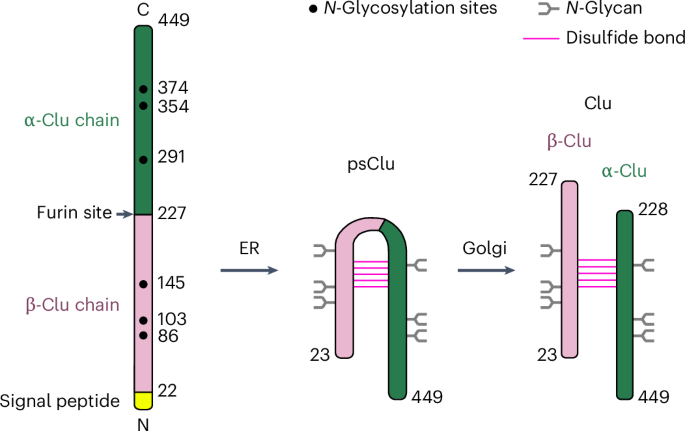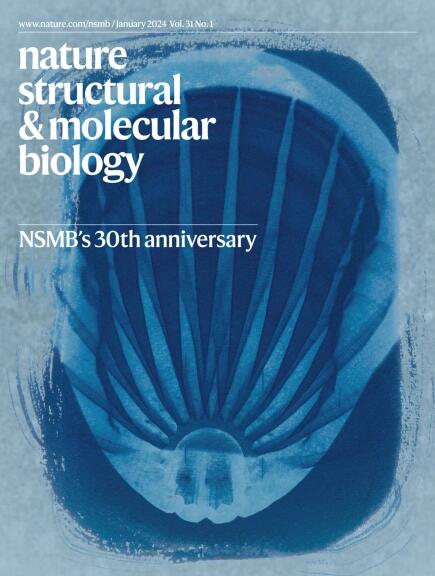结构分析确定了簇蛋白伴侣功能的分子基础
IF 10.1
1区 生物学
Q1 BIOCHEMISTRY & MOLECULAR BIOLOGY
引用次数: 0
摘要
聚簇蛋白(载脂蛋白J)是一种存在于血液和脑脊液中的保守糖蛋白,具有分子伴侣和载脂蛋白的功能。簇蛋白失调与晚发性阿尔茨海默病有关。尽管簇蛋白在细胞外蛋白酶抑制中起着重要作用,但其作用机制尚不清楚。在这里,我们展示了人类簇蛋白的晶体结构,揭示了不连续的三畴结构。基于结构的突变分析表明,两个无序的疏水肽尾部能够实现不同的活性。类似于小热休克蛋白的底物结合区,这些序列介导簇蛋白的伴侣功能,抑制淀粉样蛋白-β、tau和α-突触核蛋白聚集。与保守的表面积相结合,尾段也参与聚集蛋白与细胞表面受体的结合和细胞摄取。在促进脂蛋白形成的同时,疏水尾部仍可用于脂蛋白复合体中的伴侣蛋白功能。这些序列的显著多功能性使聚簇蛋白可以单独或与脂质结合,维持异常细胞外蛋白的溶解度,并通过内吞作用和溶酶体降解促进其清除。本文章由计算机程序翻译,如有差异,请以英文原文为准。

Structural analyses define the molecular basis of clusterin chaperone function
Clusterin (apolipoprotein J), a conserved glycoprotein abundant in blood and cerebrospinal fluid, functions as a molecular chaperone and apolipoprotein. Dysregulation of clusterin is linked to late-onset Alzheimer disease. Despite its prominent role in extracellular proteostasis, the mechanism of clusterin function remained unclear. Here, we present crystal structures of human clusterin, revealing a discontinuous three-domain architecture. Structure-based mutational analysis demonstrated that two disordered, hydrophobic peptide tails enable diverse activities. Resembling the substrate-binding regions of small heat-shock proteins, these sequences mediate clusterin’s chaperone function in suppressing amyloid-β, tau and α-synuclein aggregation. In conjunction with conserved surface areas, the tail segments also participate in clusterin binding to cell surface receptors and cellular uptake. While contributing to lipoprotein formation, the hydrophobic tails remain accessible for chaperone function in the lipoprotein complex. The remarkable versatility of these sequences allows clusterin to function alone or bound to lipids in maintaining the solubility of aberrant extracellular proteins and facilitating their clearance by endocytosis and lysosomal degradation. The authors reveal a three-domain architecture of glycoprotein clusterin and show that the hydrophobic tails are crucial for clusterin’s functions as an extracellular molecular chaperone and apolipoprotein, as well as for receptor binding and cellular uptake.
求助全文
通过发布文献求助,成功后即可免费获取论文全文。
去求助
来源期刊

Nature Structural & Molecular Biology
BIOCHEMISTRY & MOLECULAR BIOLOGY-BIOPHYSICS
CiteScore
22.00
自引率
1.80%
发文量
160
审稿时长
3-8 weeks
期刊介绍:
Nature Structural & Molecular Biology is a comprehensive platform that combines structural and molecular research. Our journal focuses on exploring the functional and mechanistic aspects of biological processes, emphasizing how molecular components collaborate to achieve a particular function. While structural data can shed light on these insights, our publication does not require them as a prerequisite.
 求助内容:
求助内容: 应助结果提醒方式:
应助结果提醒方式:


